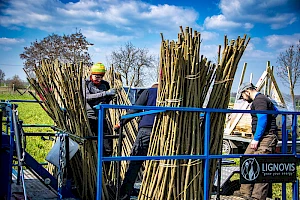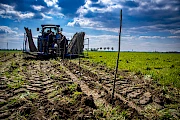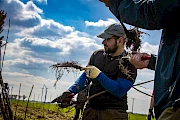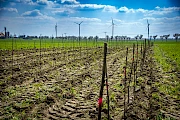What is the poplar doing in the field?
18.04.2023
 There are trees on the fields of the Lommatzscher Pflege (again) - at least they are initially rods, which should already be small trees in the fall. One farm in Sieglitz near Lommatzsch has opted for an agroforestry system on its land. And this is just the beginning! OLGA, in cooperation with farmer Marion Herrmann, the Stadt-Land-Plus 'sister project' WertVoll, the biotope network project of BUND Dresden, and the agroforestry or permaculture experts for fast-growing tree species Lignovis GmbH and Nam Nam Natura, has made short work of creating the foundations for an agroforestry system with energy and value woods.
There are trees on the fields of the Lommatzscher Pflege (again) - at least they are initially rods, which should already be small trees in the fall. One farm in Sieglitz near Lommatzsch has opted for an agroforestry system on its land. And this is just the beginning! OLGA, in cooperation with farmer Marion Herrmann, the Stadt-Land-Plus 'sister project' WertVoll, the biotope network project of BUND Dresden, and the agroforestry or permaculture experts for fast-growing tree species Lignovis GmbH and Nam Nam Natura, has made short work of creating the foundations for an agroforestry system with energy and value woods.
The agroforestry plantation in Sieglitz involves five parallel strips, each consisting of five rows of trees. The outer two strips were planted with four different performance varieties, which are now being analyzed in the growth process. The varieties planted were "Vesten" (Populus deltoides x P. nigra), "Bakan" (P. trichocarpa x P. maximowiczii), "Dender" (P. deltoides x P. trichocarpa x P. maximowiczii) and "Matrix 11" (P. maximowiczii x P. trichocarpa). These fast-growing tree stands can be used for regional energy as well as raw material production after a short multi-year growing season. The middle single strip was planted with wild cherry/bird cherry (Prunus avium ssp. avium), Norway maple (Acer platanoides), and littleleaf linden (Tilia cordata). These deciduous hardwoods are used for long-term cultivation for the production of valuable timber, which can be sold to the timber industry as veneers or solid wood after about 40-60 years.
This agroforestry crop was planted with a strip spacing of 72 m in a north-south orientation in order to significantly reduce wind erosion, improve the water balance, keep the shadows cast on the arable crops low and at the same time secure the yield in the crop rotation, especially in dry years. Wood production creates another branch of the business, which improves the diversification of the farm. This is a successful example of the combination of biodiversity, structural upgrading of agricultural land and a regional value-added option for farmers. This cultural landscape development voluntarily links agriculture with applied, production-integrated conservation - a good way to go.
We will continue to follow the development of the system and communicate the benefits of agroforestry use in Saxony in cooperation with all stakeholders - for example, by showing other farmers on site in Sieglitz how it can be done. We are staying tuned!
Fotos: Victor Smolinski




